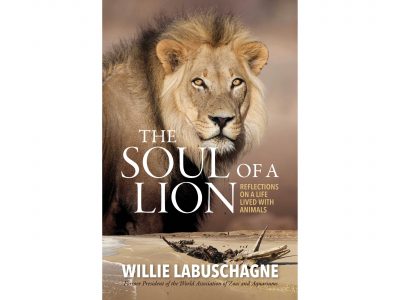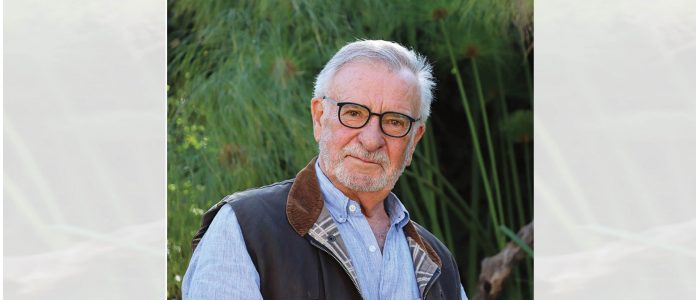He’s slept under the stars with bushmen in the desert. Raised a newborn lion cub. Faced more than one life-threatening situation with wild animals.
Wildlife conservationist and author Willie Labuschagne has truly lived an extraordinary life!
While many kids of his age only read about wild animals in books, Willie Labuschagne had a front-row seat. His father, Oom Lappies used to be the information officer at The Kruger National Park. This opened the doors for Willie to experience and learn about the majestic animal kingdom up close and personal. And he loved every moment of it. So it came as no surprise when he studied wildlife management and later got his master’s degree.
Kicking off his career as a zoologist at the Johannesburg Zoological Gardens, he steadily climbed the ladder, becoming executive director of the National Zoological Gardens of South Africa and eventually President of the World Association of Zoos and Aquariums.
For more than five decades he was actively involved in the conservation of threatened species, for which he received national and international recognition, culminating in numerous awards.
It was only a matter of time before this devoted and internationally celebrated wildlife conservationist would put pen to paper and capture his thrilling experiences in the memoir … The Soul of a Lion: Reflections of a Life Lived with Animals … a collection of his experiences which will give you goosebumps, tickle your curiosity, and enrich your knowledge about our animal kingdom and the people responsible for them!
From spending time on a diamond mining barge in Namibia to sleeping under the stars with the bushmen trackers of the Kgalagadi desert, from helping carve out the Otter Trail in the Tsitsikamma Forest to travelling to all the major national parks in Africa, as well as being part of groundbreaking research on the desert cheetah’s behaviour and ecology, Willie shares a few of his most memorable moments with us.
Favourite place you’ve travelled to?
Although I’ve been fortunate enough to see more than 60 countries in the world, nothing beats South Africa. Especially our beautiful bushveld region. But there’s also the Zaire and Amazon forests, and the beautiful Banff and Jasper National Parks in Canada. The marble cladding of Taroko National Park in Taiwan, and the expanse of the desolate Arabian desert. Austria and Switzerland are also real gems.
Your ultimate survival lesson?
I do believe that the ability to read the animal’s behaviour – a lesson my father taught me when I was a child – was significant for my survival. Never challenge an animal. You will most definitely come second. Always respect an animal and understand that they remain wild animals.
Something that you’ll never forget?
The relationship I developed with Sebastian, the lion cub that we raised because he was rejected by his mother. The bond between us was remarkable and the inspiration for the title of my book. There were other events such as the research I conducted on the cheetahs, but another significant experience in more than five decades in conservation was the day I received a call from the President’s office. Madiba wanted to visit the National Zoo! He arrived with eight of his grandchildren and we spent fantastic few hours in the zoo.
A humorous event that comes to mind?
It was in the Kgalagadi while working with the bushmen as my trackers. At a stage they became bored, so I decided to teach them how to drive the Land Rover. It all went well with me sitting outside on the bonnet until I realised … I never taught them how to stop! My friends thought the outcome was hilarious but it did take me a little longer to come to the same conclusion.
An animal that best describes your personality?
Undoubtedly the cheetah. At heart, I believe they are gentle creatures and have a natural respect for man. Apart from this, there is no recorded case of a cheetah killing a human being although I would not recommend getting between a female cheetah and her young! Interestingly enough, they seem to love human beings.
What’s the Kgalagadi really like?
It is a desolate landscape with extreme temperatures. In Summer it may reach 45°C or more and in Winter may drop to sub-zero temperatures. It is predominantly sand veld and, in some areas, notedly the Kgalagadi Gemsbok Park – where I conducted my research – consists of undulating sand dunes. The Kgalagadi harbours enormous biodiversity which includes the stately black-maned Kgalagadi lion, cheetahs, leopards, and various other predators and scavengers with a diversity of herbivores including the splendid gemsbok, springbok and southern eland.
Why the specific interest in the cheetahs in the Kgalagadi?
Simply because they behave very differently to their behaviour elsewhere, probably as a result of the extreme environmental conditions. They are very active during the evenings and also across all moon phases. This is the result of having to travel far distances in search of food but with regular resting times. These cheetahs have a killing success of less than 35 per cent. Females with cubs are more successful with a killing success of more than 85 per cent. The high predation on cheetah cubs is the singular most important factor in regulating their numbers.

An excerpt from The Soul of a Lion:
“Shortly after my family’s arrival I suggested to Irene, my sister Quinta and her husband Jan that they accompany me on a game drive along the Sabi River road. The entire area was littered with staff searching for the two elusive cheetahs. It was getting close to midday and the regular lunch break when we encountered one of the conservation staff returning to the camp for his lunch. I stopped alongside him and suggested that he should allow me the use of the immobilising gun, ‘just in case we find them’. He gave me a sarcastic smile as he handed me the gun – but he gave me only two darts. We arranged to meet after lunch when I would return the immobilising equipment.
I really did not expect anything to happen as we drove slowly along the winding gravel road. It must have been less than ten minutes later when we came across a large number of parked vehicles whose occupants had obviously seen something interesting – elephants or perhaps even lions. I pulled up next to one of the vehicles and could not believe my ears when the driver said they had spotted the two malnourished cheetahs.
Frankly, I felt like driving on, even though I had the immobilising gun. It would have been catastrophic if I could not bring to a conclusion this saga which had been going on for weeks. I hoped that when I got out of my vehicle both cheetahs would simply run away. But they didn’t. They were lying on opposite sides of the road, approximately 25 metres from my vehicle. As I got the gun and dart ready I spotted a solitary Cape buffalo bull extremely close to where I was standing and even thought that his presence should be enough excuse for me not to take action. Buffalo are notoriously dangerous and I was basically putting my life at risk. What to do? Well, I simply decided to do what I had to do.
Using an immobilising gun in the bush is not easy. A branch or clump of grasses could easily deflect the trajectory of the dart and immobilising both cheetahs with only two darts was enormously challenging. Why was this happening to me? In the presence of my bride-to-be and with my father in Skukuza, probably expecting a miracle from me. It seemed as if the entire world was waiting anxiously for me to act.
I still cannot explain how a sudden calm came over me as I aimed at the first cheetah and pulled the trigger. Jan, my brother-in-law, was the first to shout, ‘you got him’, and I hoped that his voice would chase the other cheetah off. But no. He was still there as I slowly and deliberately reloaded the gun and took aim at the second cheetah. Now it was Irene, with excitement and pride, who announced, ‘you got him too’. Wow. We loaded both the immobilised cheetahs into my Land Rover and duly delivered them to the conservation headquarters for further attention.”
You’ll find The Soul of a Lion: Reflections of a Life Lived with Animals (published by Tracey McDonald Publishers) at bookstores for around R330.
Details: thesoulofalion.com
Compiled by: ALANICKA LOTRIET. • Image: SUPPLIED.






